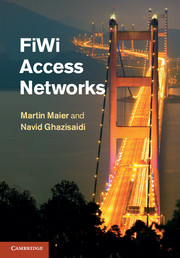Book contents
- Frontmatter
- Contents
- List of figures
- List of tables
- Preface
- Acknowledgments
- Part I Introduction
- Part II Fiber access networks
- Part III Wireless access networks
- Part IV FiWi access networks
- 10 RoF vs. R&F networks
- 11 Architectures
- 12 Network planning and reconfiguration
- 13 Techno-economic analysis
- 14 Network coding
- 15 Optical and wireless protection
- 16 Hierarchical frame aggregation
- 17 Routing and QoS continuity
- 18 Smart grid communications
- References
- Index
14 - Network coding
from Part IV - FiWi access networks
Published online by Cambridge University Press: 05 January 2012
- Frontmatter
- Contents
- List of figures
- List of tables
- Preface
- Acknowledgments
- Part I Introduction
- Part II Fiber access networks
- Part III Wireless access networks
- Part IV FiWi access networks
- 10 RoF vs. R&F networks
- 11 Architectures
- 12 Network planning and reconfiguration
- 13 Techno-economic analysis
- 14 Network coding
- 15 Optical and wireless protection
- 16 Hierarchical frame aggregation
- 17 Routing and QoS continuity
- 18 Smart grid communications
- References
- Index
Summary
Among the several next-generation passive optical network (NG-PON) requirements are the provisioning of higher bandwidth per subscriber, an increased splitting ratio, and an extended maximum reach compared with current Ethernet PON (EPON) and Gigabit PON (GPON) architectures. NG-PONs may offer additional functionalities such as protection (to be discussed in detail in Chapter 15), support topologies other than conventional tree structures, and they enable the consolidation of access, backhaul, and metro network infrastructures (Lin [2008]). In addition, substantial research activity is currently focused on the convergence of optical and wireless access architectures into bimodal fiber-wireless (FiWi) access networks (Ghazisaidi and Maier [2011]), a key feature of NG-PONs.
An important goal of FiWi research is to combine the most promising technologies proposed for wireless and optical access. Network coding (NC) is an example of such technologies. Consisting of bit- or packet-level coding operations, NC has been shown to improve throughput, simplify routing, and provide robustness against transmission errors and failures in various packet networks (Ho and Lun [2008]). In a recent study, significant throughput gains were demonstrated experimentally in NC-enabled WiFi-based mesh networks (Katti et al. [2008]).
In this chapter, we study the integration of NC within NG-PONs. The aim is to illustrate the NG-PON architectures where NC yields potential performance gains. Our illustrations and simulations demonstrate significant potential performance improvements while clarifying some underlying topological constraints of NC in various NG-PON scenarios.
- Type
- Chapter
- Information
- FiWi Access Networks , pp. 160 - 170Publisher: Cambridge University PressPrint publication year: 2011

